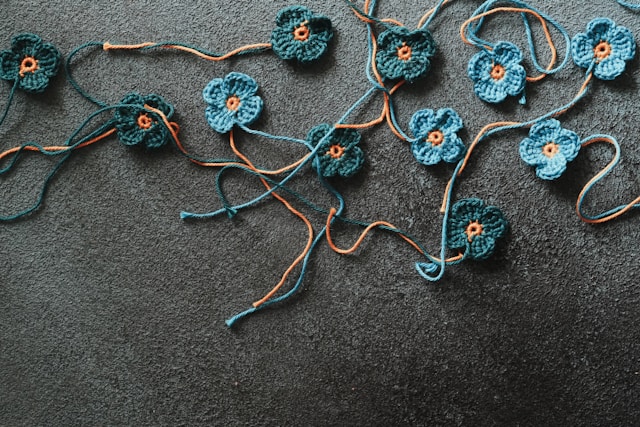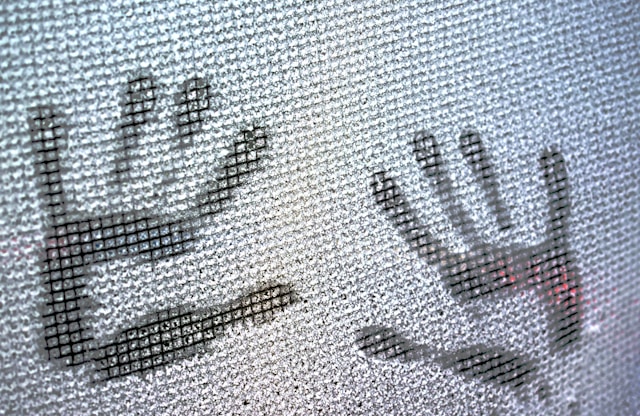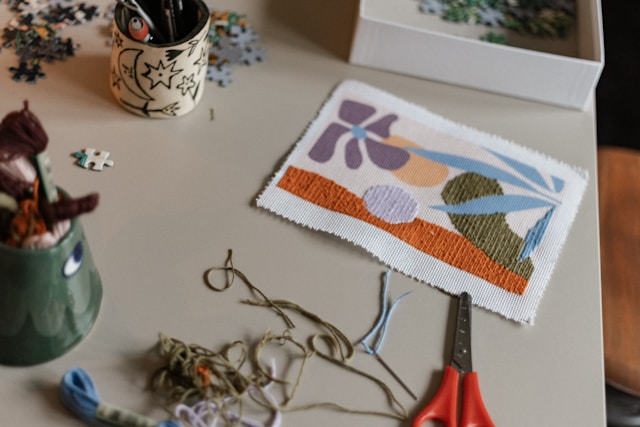Emotions don’t always come with words. Sometimes, feelings are too complex, too heavy, or too raw to articulate. This is where crafting as a form of emotional processing can be incredibly powerful.
The Feeling Stitch practice is a mindful approach to using thread, yarn, fabric, and stitching as a way to acknowledge, express, and work through emotions. Whether you’re experiencing stress, grief, joy, uncertainty, or healing, this method allows you to turn emotions into something tangible, stitch by stitch.
Unlike traditional journaling or talk therapy, which require verbal expression, the Feeling Stitch practice provides a nonverbal, tactile way to process emotions, making it particularly helpful for those who find it difficult to put feelings into words.
Learn more exercises like this one from the Craft to Heal workshop series.
Why Stitching Can Help Process Emotions
The act of stitching, knitting, weaving, or quilting provides a rhythm that can be both soothing and meditative. Engaging in repetitive, intentional hand movements has been shown to:
- Activate the parasympathetic nervous system, which helps the body shift out of stress mode and into a relaxed state.
- Provide a safe, controlled outlet for emotions, allowing feelings to be expressed through movement instead of words.
- Offer a physical manifestation of inner emotions, making them easier to process and reflect upon.
- Foster a sense of grounding, helping individuals stay present rather than getting lost in overwhelming thoughts or emotions.
By engaging in Feeling Stitch, you give yourself permission to acknowledge emotions without judgment, work through them at your own pace, and create something personal in the process.
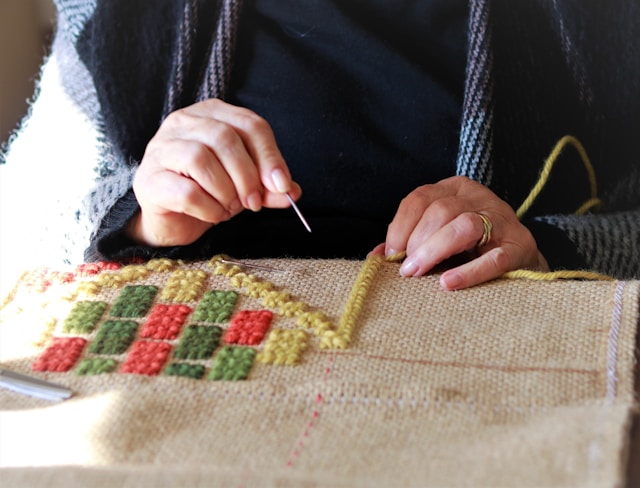
How to Start a Feeling Stitch Practice
1. Choose a Color That Reflects Your Emotional State
Color is deeply tied to emotion and energy. Before you begin, take a moment to check in with yourself and choose a thread, yarn, or fabric that resonates with what you’re feeling.
- Warm colors (reds, oranges, yellows) – Represent passion, energy, anger, or excitement.
- Cool colors (blues, greens, purples) – Symbolize calmness, sadness, peace, or introspection.
- Dark shades (black, deep gray, navy) – Reflect grief, loss, or heaviness.
- Bright colors (pink, gold, turquoise) – Evoke hope, joy, creativity, or renewal.
This choice doesn’t have to be logical—go with what feels right. The simple act of choosing a color helps bring awareness to your emotional landscape before you even begin stitching.
2. Stitch Without a Plan—Let the Process Guide You
Once you have your materials, let go of expectations. Unlike following a pattern or creating something structured, Feeling Stitch is about freeform expression.
- Begin with a simple stitch—running stitch, backstitch, cross-stitch, or embroidery knots.
- Let your hands move intuitively. Stitch loosely, tightly, densely, or sparsely, depending on what feels right.
- If your emotions shift, allow your stitching to reflect that. You might start with small, controlled stitches and move toward longer, sweeping ones—or vice versa.
There’s no “right” way to do this. The goal is not perfection—it’s presence.
3. Notice How Stitching Affects Your Emotional State
As you work, take mental note of any changes in how you feel. Ask yourself:
- Does the tension in your body ease as you stitch?
- Do you feel more clarity, or do emotions surface that you weren’t fully aware of?
- Does the movement of the needle or yarn bring a sense of comfort, relief, or control?
This step is about self-awareness rather than trying to “fix” or change anything. Some days, you may feel a sense of release, while other days, the stitching simply serves as a neutral act of self-care. Both are equally valuable.
4. Allow the Final Piece to Hold Meaning—Or Let It Go
At the end of a session, you might look at your stitched piece and see emotions visually represented in the fabric. Some people choose to:
- Keep their pieces as a visual record of their emotional journey.
- Add to the same fabric over time, creating a layered story of feelings stitched together.
- Stitch directly into a journal or fabric book, incorporating notes or reflections.
- Cut up or unravel the stitches after finishing, symbolizing release and transformation.
How you handle the final piece is entirely up to you. The power is in the process itself, not just the end result.
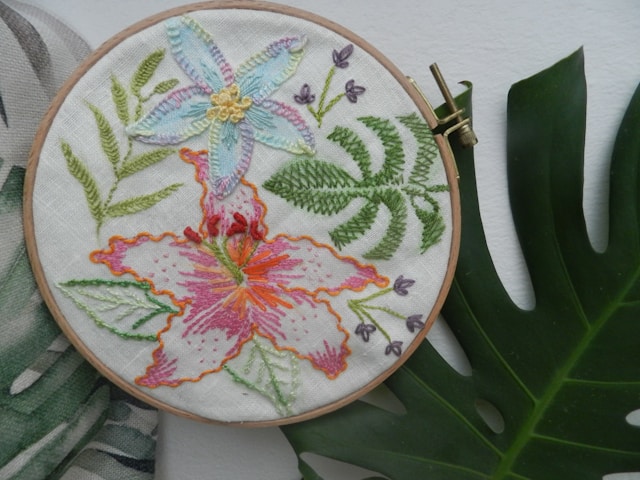
Variations of the Feeling Stitch Practice
While the method above provides a basic structure, there are countless ways to adapt Feeling Stitch to suit your personal needs and creative style.
Emotion Mapping with Stitches
Instead of using one color, assign different stitches to different emotions. For example:
- Chain stitch – Joy, hope, new beginnings
- French knots – Anxiety, nervous energy
- Long running stitches – Calm, peace, movement forward
- Chaotic overlapping stitches – Frustration, overwhelm
As you stitch, let the piece build organically based on how you feel in the moment.
Grief Quilting or Memory Stitching
If you are processing loss or deep emotions, consider using materials with personal significance:
- Fabric from a loved one’s clothing
- A handkerchief, old scarf, or sentimental textile
- A section of an unfinished project that can be reworked
This practice allows you to honor memories while working through feelings in a gentle, creative way.
Stitching with Breath Awareness
For those who struggle with anxiety, combining breathwork with stitching can create a powerful calming effect. Try:
- Inhaling as you pull the thread through fabric and exhaling as you complete the stitch.
- Stitching slowly and deliberately, syncing each stitch with a deep breath.
- Counting stitches like a mantra (e.g., “one, two, three” for relaxation).
This practice enhances mindfulness, relaxation, and emotional regulation.
Why Feeling Stitch Works for Emotional Well-Being
Many traditional forms of emotional processing focus on talking or writing—but for those who feel overwhelmed by verbal expression, fiber arts provide an alternative pathway.
- The rhythmic, repetitive movement of stitching soothes the nervous system.
- The act of using hands to create offers a sense of control and empowerment.
- Colors, textures, and stitches make emotions visible, helping them feel more understood and processed.
For many, stitching becomes a personal form of meditation, allowing them to work through emotions in a way that feels natural, calming, and deeply personal.
The Feeling Stitch practice is a simple yet profound way to connect with emotions through fiber arts. Whether used occasionally or as a regular practice, it offers a nonverbal, tactile method for self-expression, emotional release, and healing.
There’s no right or wrong way to do it—just you, your materials, and a moment of creative self-reflection.
